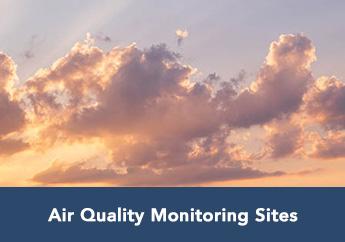
Air monitoring is required under the federal Clean Air Act (CAA). Parts 50 and 58 of title 40 of the Code of Federal Regulations (40 CFR), details the siting and operating of air monitoring sites and operating air monitoring instruments in a way to ensure that the data collected are valid.
The State of Missouri operates a network of about 50 ambient air monitoring sites. The main purpose of this air monitoring network is to determine whether areas in Missouri are meeting the primary National Ambient Air Quality Standards (NAAQS). These standards are established by EPA to protect human health effects and are available in the NAAQS Table. Data from the monitoring network are sent to EPA’s national database of air monitoring data, called the Air Quality System (AQS). This air monitoring network also helps develop information on air quality for the citizens of Missouri. Concentrations of most air pollutants are measured continuously, with hourly averages reported. A detailed description of the network and demonstration that it is intended to meet all the ambient air monitoring federal requirements are included in an annual monitoring network plan.
In addition to the basic required monitoring sites, called State and Local Air Monitoring Stations (SLAMS), Missouri also operates special purpose monitors (SPM). For example, for short term air quality studies or instrument evaluation and monitors for trends in concentrations of toxic air pollutants at a site in St. Louis as a part of the National Air Toxics Trends Sites (NATTS) network.
In addition to monitoring done by the state, some industrial facilities in Missouri conduct air monitoring near their facilities. This monitoring is done following quality assurance requirements reviewed and approved by the state, and site operation and instrument performance at these sites are periodically reviewed (audited) by the state. These industrial sites are also identified in the annual monitoring network plan. Data from these sites are also reported to the AQS database.
Pollutant Monitoring
The NAAQS are set for the six criteria pollutants, ozone, sulfur dioxide, nitrogen dioxide, carbon monoxide, lead and particulate matter. If monitoring data shows that an area does not meet the standards, a plan is developed to address emissions that contribute to the problem.
A group of 187 other air pollutants called hazardous air pollutants are address by section 112 of the Clean Air Act. Although they are found in the ambient air, there are no federal ambient air quality standards set to address these pollutants. Instead, federal rules are established to place emissions standards, or requirements, on sources of hazardous air pollutants called new source performance standards. These standards place national emission standards for hazardous air pollutants for 174 named categories of sources that emit hazardous air pollutants to the air.
Missouri monitors long-term air toxics trends in the ambient air at one site in St. Louis City and implements a permitting program for major sources of hazardous air pollutants.
